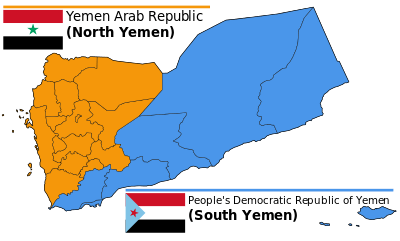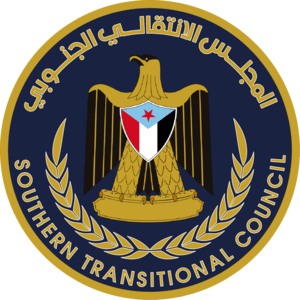Southern Movement
| Southern Movement | |
|---|---|
|
الحراك الجنوبي Participant in the South Yemen insurgencythe Yemeni Civil War, and the Yemeni Revolution | |
 | |
| Active | 2007–present |
| Ideology | South Yemeni independence or autonomy |
| Leaders |
Ali Salem al Beidh Hassan al-Ba'aum Saleh Ali Bin-Ghaleb Ahmed Omar Bin Fareed Abd Al-Rahman Ali Al-Jifri Saleh Bin Fareed Aidroos Al Zubaidi Shalal Ali Shayih |
| Area of operations | Yemen |
| Allies |
|
| Opponents |
|
| Website | southernhirak.org |
The Southern Movement (Arabic: الحراك الجنوبي al-Ḥirāk al-Janūbiyy), sometimes known as the Southern Separatist Movement, or South Yemen Movement, and colloquially known as al-Hirak,[1] is a political movement and paramilitary organization active in the south of Yemen since 2007, demanding secession from the Republic of Yemen and a return to the former independent state of South Yemen. At present, its political branch, the Southern Transitional Council led by Aidarus al-Zoubaidi, is the de facto leadership in all provinces of the south.[2]
History

After the union between South Yemen and North Yemen on May 22, 1990, a civil war broke out in 1994. This came after leaders of the former independent southern state declared an end to the unity deal amidst an alleged power-grabbing usurp by their northern counterparts. The result was a swift defeat of the weakened southern forces and the expulsion of most of its leaders out of Yemen, including the former Secretary-General of the Yemeni Socialist Party and the Vice-President of the unified Yemen, Ali Salim al-Beidh.[3]
After the 1994 civil war, calls for southern independence were successfully put down and the national unity was maintained. Grievances however remained high amongst many residents of the south. Accusations of corruption, nepotism and electoral fraud were levelled against the new ruling party based in Sana'a, led by President Ali Abdullah Saleh, as well as a mishandling of the power-sharing arrangement agreed to by both parties in the 1990 unity deal.
Many in the south also felt that their land, home to much of the country's oil reserves and wealth resources,[4] was being exploited after the unity deal. Privately owned land was seized and distributed amongst individuals affiliated with the Sana'a government. Several hundred thousand military and civil employees from the south were forced into early retirement, and compensated with pensions below the subsistence level. Although equally low living standards were prevalent throughout the whole of Yemen, many in the south felt that they were being intentionally targeted and dismissed from important posts,[5] and being replaced with northern officials affiliated with the new government. The city of Aden, the former capital city of South Yemen, was also seen to be neglected both socially and economically, whilst investments appeared to be focussed instead on Sana'a, the new capital.
Beyond the economic grievances were also cultural and social ones too. Many in the south long believed they held a distinct historical path with their northern neighbours, which became more evident after the 1990 unity. After 128 years of British rule, South Yemen was an independent state for 23 years. Despite economic difficulty in its later years with the collapse of its main backer the Soviet Union, the socialist state prided itself on its free healthcare, education and welfare system. Many in Aden today speak foreign languages or have technical skills as a result of their state-sponsored education abroad enjoyed in the days of pre-unity South Yemen. Unlike the north, tribalism was looked upon with disdain and generally stamped out of everyday life in the south, which instead preferred the law and order of civil society passed onto them from British rule. Post-1994 unity saw a gradual return of tribalism into southern society. It is not uncommon for residents of the south to even refer to those from the north as being "mutikhalifeen" or backward.[6]
In May 2007, grieving pensioners who had not been paid for years began to organise small demonstrations demanding better rights and an end to the economic and political marginalization of the south. As the protests spread throughout Aden and grew more popular, so to did the demands of those protesting. Eventually, calls were being made once again for the secession of the south and the re-establishment of South Yemen as an independent state. The government's response to these peaceful protests was heavy-handed, labelling them as 'apostates of the state' and using live ammunition to disperse the crowds.[7]
This eventually gave birth to the Southern Movement, which grew to consist of a loose coalition of groups seeking a complete secession from the north.[8] Their presence in the south was restricted, and their actions were limited to the organising of protests and marches across the south which were often met with deadly violence. To raise the former flag of South Yemen was considered a crime in Aden, although a common practice outside of the city where government control was limited.
Since 2015
In 2015, the Southern Movement rose to prominence after entering into a loose alliance with the exiled President Hadi and proving to be a vital force in the pushback against Houthi forces from the southern city of Aden,[9] receiving both financial and military assistance from members of the Gulf coalition as a result.
Today, the Southern Movement through its political branch the Southern Transitional Council has a significant presence in all areas of the former southern territories. Flags of the former southern republic are flown from Aden to Hadramout, often alongside those of the Arab coalition as a gesture of gratitude for their ongoing support.

In January 2018, the STC broke away from Hadi after clashes in the city of Aden saw their forces overrun all governmental buildings aligned to the president in exile. At present, the STC, led by Aidarus al-Zoubaidi, is the de facto leadership in all provinces of the south.
According to Reuters after the 1994 Yemeni unification, the leaders of al-Hirak were exiled in Hezbollah-controlled Beirut and received training from Iran's Islamic Revolutionary Guard Corps. In 2015, the leaders of the movement moved to Abu Dhabi and allied themselves with the United Arab Emirates, leaving Iran's orbit. "They want to fight Iranian militias trying to seize our lands, and we do too. This is enough for the alliance to make sense for now," one southern official told Reuters.[10]
See also
References
- ↑ "Is South Yemen Preparing to Declare Independence?". Time. 2011-07-08.
- ↑ "Advancing separatists could restore South Yemen". Al-Monitor. 1 February 2018.
- ↑ al-Suwaidi, Jamal S., ed. (1995). The Yemeni War of 1994: Causes and Consequences. Emirates Center for Strategic Studies and Research. ISBN 0863563007.
- ↑ "North Yemeni Troops Seize Oil Field Center; Region Controls Country's Chief Resource". 1994-05-25.
- ↑ Kambeck, Jens (2016). "Returning to Transitional Justice in Yemen". Bonn: Center for Applied Research in Partnership with the Orient.
- ↑ "In Yemen's Aden, anger mixes with nostalgia". 2010-01-21. Retrieved 2018-02-09.
- ↑ "In the Name of Unity". 2009-12-15. Retrieved 2016-08-03.
- ↑ "Yemen: End Harsh Repression in South". 2009-12-15. Retrieved 2016-08-03.
- ↑ "Saudi-Backed Forces Said to Wrest Aden, Yemen, From Houthis". 2015-07-17.
- ↑ Browning, Noah. "UAE extends military reach in Yemen and Somalia". reuters.com.
External links
- The Southern Movement in Yemen, Gulf Research Center, April 2010
- Yemen's Southern Challenge, Critical Threats (American Enterprise Institute), November 2009
- Website